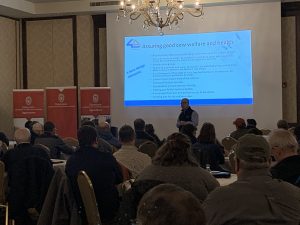According to Dr. Doug Reinemann, UW-Madison milking system specialist and College of Agricultural and Life Sciences Associate Dean for Extension and Outreach, over 300 U.S. dairy farms have automatic milking systems (AMS), also known as robotic milking systems. That number is much higher in Canada and even greater in Europe. Some reasons for choosing automatic milking systems include a lack of labor, including reliable labor, and flexibility when cows are milked. Although dairy farmers may choose robotic milking systems for the aforementioned reasons, AMS requires a very high level of management and service skills. In addition, robotic milking systems are capital-intensive investments.
This past month Extension Dairy & Livestock Agent Tina Kohlman co-developed, -organized, and -hosted “Building Our Dairy Future: Robotic Milking System Performance and Efficiency” with several regional extension agriculture colleagues. Over 90 dairy farmers, consultants, agriculture lenders, equipment dealers, and facility designers attended the one-day meeting featuring Jouni Pitkaranta, architect, 4DBarn, Finland; Jim Salfer, Regional Dairy Specialist, University of Minnesota Extension; and a panel consisting of a farm couple who installed a robotic milking system and their lender, builder, and system dealer.
As a result of the meeting, participants to a post-meeting evaluation (n=49) indicated a +1.0 point (on a 5-point Likert Scale) increase in knowledge on facility design considerations for an automatic milking system (AMS); +1.1 point increase in factors affecting profitability of AMS; +1.1 point increase in key factors affecting labor efficiency in AMS; and +1.0 point increase experiences and challenges with planning and implementing an AMS.
Based on the meeting, one participant shared, unsolicited, via email, “The robotic meeting today that extension hosted was well put together and very informative. Thanks for helping organize/put together. A job well done!”







